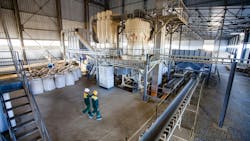When Particles Clump: How To Solve Sticky Solids
Key Highlights
- Moisture is the enemy: Hot solids with residual moisture create clumping problems that worsen during storage and temperature changes.
- Size matters: Enlarging particles through agglomeration or pre-forming reduces stickiness and improves conveying properties.
- Keep it moving: Pastes and slurries cause the most headaches — avoid storage when possible and use continuous processing instead.
The fundamentals I learned in college were very useful in analyzing and understanding solids processing. However, I found many exceptions that were hard to explain, because particulate solids are always a two-phase mixture, which gives them an additional degree of freedom. Besides physical changes, chemical interactions may complicate the situation.
Agglomeration
One example is the agglomeration of particles, often an unwelcome result of handling. Rolling particles over one another can increase the surface energy or impart a charge to the surface. If water is in the atmosphere around the particles, the surface charge will attract the dipole of the water and draw the particles closer together; Van der Waals forces can continue to hold the solids together even after the water has been removed. Many granulators take advantage of this to convert a fine powder into an attrition-resistant particle. However, this mechanism can work against you in the form of clumps of product. Most clumping is not appreciated.
We had a very fine particle meant to dissolve rapidly for the customer. The bags were filled as the product was produced. As a consequence, the solids were hot. Unfortunately, the product had a residual interstitial moisture that was released during storage. The warm solids drove off attracted moisture, but allowed the bulk material to clump during storage. Had this been the only problem caused by the clumping, the story would end there. However, the moisture trapped in the bulk bag condensed and dissolved some of the solids as the bags went through different temperature environments. As the temperature of the solids dropped, the solution crystallized into clumps, making dumping the bag expensive for the customer.
Particulate solids can be troublesome to handle at times, as described above, but pastes, cakes and slurries can cause your hair to turn gray. While some are pumpable, others require special treatment to prevent changing the overall characteristics of the product.
The biggest problems often occur in storage and conveying processes. As a consequence, we try not to store these products. If we do, we keep them moving. Luckily, these products are intermediates to a particulate solid form of the chemical. All is not lost as we have options to improve handling without changing the chemical.
Solids Handling Options
Pre-forming pastes using roller or pressure extruders, with or without a cutter, can create a more uniform feed or even pellets that dry quicker or don’t stick to the feed zone of calciners or kilns. Pre-formed or extruded material with high strength may allow use of screw or vibratory conveyors for transport.
Size enlargement improves the handling properties of wet solids because the internal shear strength and wall friction generally decrease as material size increases. Enlargement can reduce caking and lump formation, lessen hazards associated with noxious materials, and create a better blend that doesn’t separate. Techniques include agglomeration, briquetting and granulation. You can grind the material, once dried, to the desired size.
Shear-strength reduction of a paste or cake can allow low-pressure pumping over long distances of a material that otherwise would require a high-pressure pump limited to only short distances. A high-shear mixer or agitator, either on its own or as part of a feeder, can do the job. This technique suits thixotropic materials as well as material from compression filters, because the moisture in the cake can be redistributed to decrease stickiness.
Partial drying of the cake surface can reduce the tendency of the material to stick to the equipment surfaces. In addition, cooling of equipment surfaces sometimes lessens adhesion. Companies in the food industry often rely on this approach to improve hygiene and flowability. Another method is to blend part of the dry material with wet material. For wet cake, a double paddle mixer is common; for slurry, a high-speed mixer is preferred.
You can improve the flow curve (shear stress versus shear rate) of pumpable pastes through use of flocculants or dispersants to pare power requirements. Wet grinding of particles to below 5 microns can form a flocculated product that behaves like a coarse material, without adding another chemical.
Size distribution, shape and concentration all change the viscosity and pumpability. A wide size-distribution material of rounded, low-aspect ratio particles has a lower viscosity at the same solids concentration. Diluting the concentration generally will reduce viscosity, but at an increased cost. However, at very high solids concentrations, a small change in concentration can be very effective.
Some other methods of creating stabilized slurry involve using fine particles to create a denser non-Newtonian suspended medium and relying on fibers or oils to agglomerate coarse solids.
Slurry, paste and cake processing is both a chemical and physical challenge. Some items required to design these systems include particle size distribution, fluid viscosity, solids loading, particle shape, stickiness, chemical composition (both of particles and fluid), density (particle and fluid) and extrinsic parameters such as temperature and pressure. Phase-change parameters such as enantiomers and polymorphs, along with particle shear properties, can complicate application of a technology. Begin by looking at what bulk properties you can manipulate in your process.
